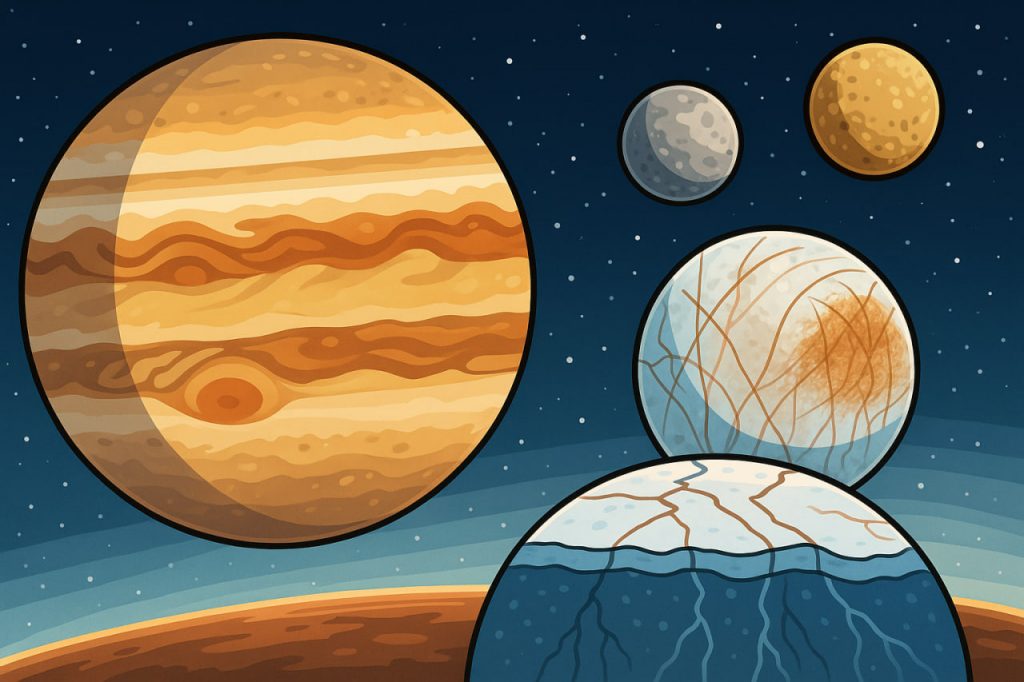Jupiter is not just the largest planet in our solar system — it’s also a host to dozens of fascinating moons, including several that are covered in ice. These icy satellites, such as Europa, Ganymede, and Callisto, have become prime targets in the search for extraterrestrial life and in understanding the history of the solar system. Hidden beneath their frozen surfaces, scientists believe there may be vast subsurface oceans, making them some of the most exciting worlds for exploration.
Europa: A Potential Ocean World
Europa, one of Jupiter’s four largest moons, is slightly smaller than Earth’s Moon and is believed to have a liquid water ocean beneath its icy crust. The surface is smooth and bright, crisscrossed with cracks and ridges — signs that the ice may be floating on a mobile layer of water.
Why is this important? Because liquid water, combined with the presence of energy and chemical elements, is one of the key ingredients for life as we know it. Some scientists even think Europa could support microbial life in its ocean, possibly near hydrothermal vents on the ocean floor, just like similar systems on Earth.
Ganymede: The Largest Moon in the Solar System
Ganymede is the largest moon in the solar system — even bigger than Mercury. Like Europa, it may have a saltwater ocean beneath its icy crust. What makes Ganymede especially interesting is that it is the only moon known to have its own magnetic field. This could influence how particles from Jupiter’s powerful magnetosphere interact with the moon’s surface and atmosphere.
Studying Ganymede helps researchers understand how icy moons evolve over time, how magnetic fields work in such environments, and whether the ocean below could be stable enough for long-term habitability.
Callisto: An Ancient, Quiet World
Callisto is the most heavily cratered object in the solar system, suggesting that its surface has not changed much for billions of years. Yet, models suggest it could still host a subsurface ocean.
Because Callisto is geologically inactive and relatively far from Jupiter’s radiation, it is considered one of the safest places for future human exploration. This makes it an important reference point when comparing the habitability of different icy bodies.
Why These Moons Matter for Science
Studying Jupiter’s icy moons gives scientists several major opportunities:
- Search for life: Oceans beneath the ice may provide conditions similar to early Earth.
- Understand planetary formation: Their structures reveal how moons form and evolve.
- Model exoplanets: Icy moons help us understand distant frozen worlds outside the solar system.
- Prepare for missions: Data helps design future spacecraft and robotic explorers.
Future missions like ESA’s JUICE and NASA’s Europa Clipper are set to explore these moons more deeply in the coming decade, using radar, cameras, spectrometers, and magnetometers to probe beneath the surface.
Challenges in Studying Icy Moons
Despite their promise, these moons present real challenges:
- Distance: They are extremely far from Earth, requiring long-duration missions.
- Radiation: Jupiter’s strong magnetic field creates a harsh environment for electronics.
- Thick ice shells: Penetrating the surface to reach the oceans is technologically difficult.
Still, the potential scientific payoff is enormous — from understanding planetary processes to possibly detecting signs of life beyond Earth.
Glossary
- Icy moon: A natural satellite with a surface composed mostly of water ice.
- Subsurface ocean: A layer of liquid water beneath a planet or moon’s icy crust.
- Hydrothermal vents: Openings in the seafloor where heated, mineral-rich water is released.
- Magnetosphere: The area around a planet or moon influenced by its magnetic field.
- Radiation: High-energy particles that can damage electronics and biological systems.
- JUICE: Jupiter Icy Moons Explorer, a mission by the European Space Agency.
- Europa Clipper: A NASA mission to study Europa’s habitability and subsurface ocean.


